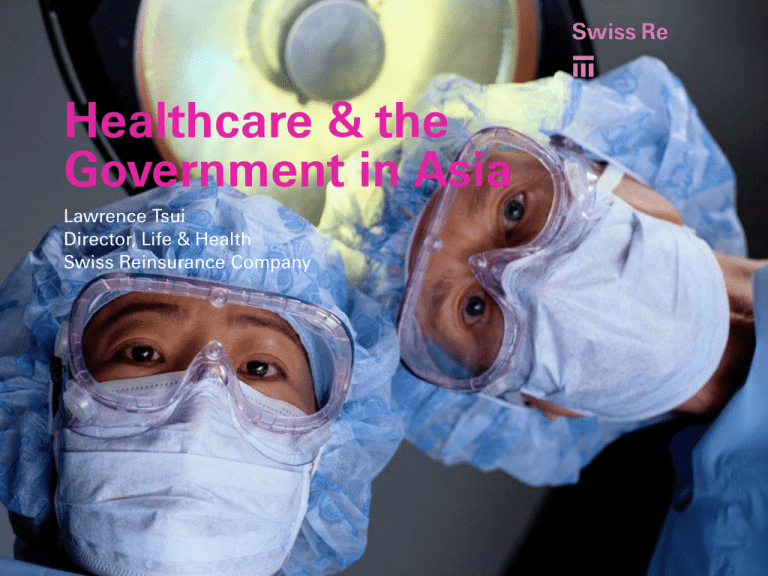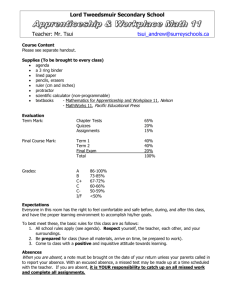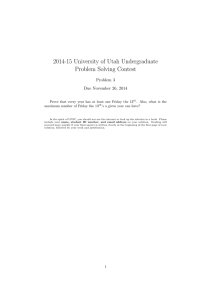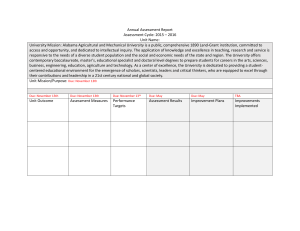
Healthcare & the
Government in Asia
Lawrence Tsui
Director, Life & Health
Swiss Reinsurance Company
Agenda
The Role of Government in Health
Government vs Insurer Objectives
Impact of Government Policy on Private Insurers
Conclusions and Lessons
Lawrence Tsui | 13th Global Conference of Actuaries | February 2011
2
The Role of
Government in Health
Lawrence Tsui | 13th Global Conference of Actuaries | February 2011
3
Who pays the bills?
Split between Government and Private Expenditure on Health
Government
Private
General
Taxation
Social Health
Insurance
Private
Insurance
Out of Pocket
and Other
China
19.1%
25.6%
3.9%
51.4%
Hong Kong
54.8%
0.0%
12.4%
32.7%
India
21.8%
4.4%
1.5%
72.3%
Japan
15.5%
65.8%
2.6%
16.1%
Korea
11.3%
43.6%
4.1%
41.0%
Malaysia
44.1%
0.3%
8.0%
47.6%
Singapore
31.0%
1.6%
1.9%
65.5%
Thailand
66.3%
6.9%
5.2%
21.6%
Source: WHO World Health Statistics 2010, Hong Kong Health Department
Lawrence Tsui | 13th Global Conference of Actuaries | February 2011
4
The Role of Government in Health
Funding / Financing
– Redistribution of wealth via general taxation
– Establishment of funding vehicles for health financing
Supply / Resourcing
– Licensing and regulation of facilities and healthcare providers
– Establishment and maintenance of healthcare facilities
Pricing / Cost-Control
– Negotiating / setting the price of healthcare services
– Limiting access to healthcare services
Regulation
– Regulation of insurance business and insurance companies
Lawrence Tsui | 13th Global Conference of Actuaries | February 2011
5
What does the Government control?
Government Hospitals
Private Hospitals
Price
Access
Price
Access
SHI
Long Wait
No
No
Subsidy
Wait
No
No
India
Almost Free
Long Wait
No
No
Japan
SHI
SHI
For SHI only
For SHI only
Korea
SHI
SHI
For SHI only
For SHI only
Malaysia
Subsidy
Wait
No
No
Singapore
Tiered Subsidy
Varies by Tier
No
No
Almost Free
Wait
No
No
China
Hong Kong
Thailand
Lawrence Tsui | 13th Global Conference of Actuaries | February 2011
6
Why purchase Private Health Insurance?
China
Coverage of SHI copayments
Coverage for non-SHI services and private hospitals
Hong Kong
Coverage for private hospitals
India
Coverage for private hospitals
Japan
Coverage of SHI copayments
Coverage for room upgrades and non-SHI services
Korea
Coverage of SHI copayments
Coverage for room upgrades and non-SHI services
Malaysia
Coverage for private hospitals
Singapore
Coverage for non-subsidised public hospital charges
Coverage for private hospitals
Thailand
Coverage for private hospitals
Lawrence Tsui | 13th Global Conference of Actuaries | February 2011
7
Government vs
Insurer Objectives
Lawrence Tsui | 13th Global Conference of Actuaries | February 2011
8
Government objectives for healthcare
Maximise access to healthcare
– Restrictions on underwriting and cancellation of insurance
– Restrictions on policy exclusions and product design
(eg pre-existing conditions, policy limits)
– Restrictions on pricing of private health insurance (especially risk rating)
Control government expenditure on healthcare
– Controls over provider charges and reimbursements
– Increased restrictions on government-funded healthcare
(eg means testing, increased copayments, etc)
– Encouragement of or incentives for private health insurance
(eg tax deduction, subsidy, etc)
Lawrence Tsui | 13th Global Conference of Actuaries | February 2011
9
Linkages and Conflicts
Restrictions on underwriting
Compulsory / near-compulsory
Restrictions on policy exclusions
and product design
Level-playing field for incumbents
and new entrants
Restrictions on pricing
Compulsory cover and/or
cross-subsidy pools
Choice of provider
Standard provider charges
Withdraw government funding
Encourage private provision
Lawrence Tsui | 13th Global Conference of Actuaries | February 2011
10
Case Study: India RSBY
Below Poverty Line (BPL) population
– limited access to healthcare
– limited ability to pay for major healthcare
RSBY involves multi-party partnership
– government – central and state
– insurers – PSU and private
– hospitals and healthcare providers – public and private
– intermediaries – Self Help Groups and NGOs
– TPAs and Smart Card / IT Vendors
Lawrence Tsui | 13th Global Conference of Actuaries | February 2011
11
Case Study: India RSBY
Government Role
– Financing of premiums up to Rs.750 per family per annum
(with Rs.30 co-contribution from insured family)
– Promotion of schemes to ensure maximum take-up
– Tender process for insurers and service providers
– Coverage design and structuring to balance access to care with cost control
– full cover for pre-existing conditions, including maternity (since Apr 2009)
– cashless reimbursement via biometric smart cards after pre-authorisation
– restricted to up to 5 family members and Rs.30,000 per annum
– fixed package rates for key treatments (780+ with slight variations between
states) including pre and post hospitalisation, day surgery
– full choice between empanelled hospitals (public or private)
– limited provision for transport allowance
Lawrence Tsui | 13th Global Conference of Actuaries | February 2011
12
Case Study: Australia
Healthcare in government hospitals is mostly free
– Medicare – funded from general tax revenue and surcharges)
– Often subject to long waiting lists for non-emergency treatment
Private health insurance primarily covers
– elective procedures (no waiting list)
– choice of doctor
– private room (government or private hospital)
– maternity and ancillary benefits (dental, optical, etc)
Lawrence Tsui | 13th Global Conference of Actuaries | February 2011
13
Case Study: Australia
Old Private Health System
New Private Health System
– No underwriting except for waiting
periods and product design exclusions
– No underwriting except for waiting
periods and product design exclusions
– Community Rating
All pay the same regardless of age,
sex, health status
Couples pay 1.5 x Single
Families pay 2.0 x Single
– Lifetime Community Rating
Rate depends on the age at which
member entered the Private Health
Insurance system
Lowest Rate for entry < 30, increasing
by 2% pa
– Spiral of declining membership
(especially among younger lives),
increasing costs, increasing
premiums, leading to declining
membership
– Burden of healthcare costs shifting to
Medicare
Lawrence Tsui | 13th Global Conference of Actuaries | February 2011
– Medicare Surcharge
High earners (A$70,000 pa) pay tax
surcharge (1%) if they do not have
private health insurance
– Private Health Insurance Rebate
Premium is subsidised by the
government (now means-tested)
14
Case Study: Hong Kong
Government hospitals costs HKD 100 (USD 13) per day
– People feel like they are already paying for hospital care
– People do not know what the actual cost is (subsidy is around 95%)
Private hospitals cost much more (HKD 1,000+ per day)
– Private hospitals and doctors are free to charge as they wish
– There is no “standard” fee schedule for doctors and surgeons
– Charges vary according to the hospital room type
(proxy for what the patient can afford)
Current HK public healthcare system (already low expenditure relative to
OECD countries) is unsustainable with current tax base, ageing
population and medical inflation
Lawrence Tsui | 13th Global Conference of Actuaries | February 2011
15
Case Study: Hong Kong
Healthcare reform
– still under discussion (after many years!!!)
– increase government expenditure on healthcare (from 15% of government
revenue to 17% by 2012)
– key proposals
– enhance primary care
– promote public-private partnership
– develop electronic record sharing
– strengthen public healthcare safety net
– reform healthcare financing arrangements
– key hidden objective – pay more for healthcare
Lawrence Tsui | 13th Global Conference of Actuaries | February 2011
16
Case Study: Hong Kong
Private insurance initiatives – “signals” received so far
– voluntary participation
– objective of portability
– insurance and savings components
– restrictions on pre-existing condition exclusions and cancellation of in force
policies
– prevent discrimination against elderly and high risk policyholders
Key concerns from private industry
– moral hazard from underwriting / exclusion restrictions
– unsustainable cross-subsidies between high and low risk lives in voluntary
environment
– little control over medical service provider fees
Lawrence Tsui | 13th Global Conference of Actuaries | February 2011
17
Impact of
Government Policy
on Private Insurers
Lawrence Tsui | 13th Global Conference of Actuaries | February 2011
18
Intersection between government policy
and private insurance
Insurance covering “gaps” in government reimbursement
Funding system for healthcare providers
Supply of healthcare facilities, especially in countries where demand
outstrips supply
Shifting provision of healthcare between government and private
healthcare facilities
Changes in regulations relating to treatments, pharmaceuticals, medical
devices, etc
Lawrence Tsui | 13th Global Conference of Actuaries | February 2011
19
Case Study 1: India RSBY
Government action influences claims behaviour
– High level of awareness/education about RSBY in the community generally
leads to high claims experience in the early phase of the scheme, especially
related to treatment for pre-existing conditions
– However, active promotion and high enrolment rates should also lead to lower
claims experience in the long run, with more healthy lives enrolled
– Government efforts to increase the scope of coverage beyond the original
scheme design could lead to increased claim costs / lower profit margins for
insurers (extensions of coverage are much more common than removal of
coverage)
– Areas with a higher density / supply of empanelled hospitals generally have
worse claims experience
– Potential conflicts between political objectives and insurer objectives
Lawrence Tsui | 13th Global Conference of Actuaries | February 2011
20
Case Study 2: Korea
What is going on with Ages 0-4?
Korea Population Hospitalisation Incidence Trends
Hosp Incidence vs 2003
220%
200%
180%
160%
140%
120%
100%
80%
2003
2004
2005
2007
2006
Year
Overall Age-Adjusted Incidence
Ages 5-19 Incidence
Ages 0-4 Incidence
Ages 20-59 Incidence
Ages 60+ Incidence
Lawrence Tsui | 13th Global Conference of Actuaries | February 2011
21
Case Study 2: Korea
From January 2006, National Health Insurance copayment for inpatient
hospital treatment for children aged 5 or below was reduced (mostly from
20% to 0%)
Changes in government policy cause changes in healthcare seeking
behaviour
Lawrence Tsui | 13th Global Conference of Actuaries | February 2011
22
Case Study 3: Japan
What is driving this trend?
Japan Hospitalisation Claims Cost Trend - Male
120.0%
Experience vs 2001 (= 100%)
115.0%
110.0%
50-54
105.0%
55-59
100.0%
60-64
95.0%
65-69
90.0%
70-74
85.0%
75-79
80.0%
75.0%
70.0%
1997
1998
1999
2000
2001
2002
2003
2004
2005
Year
Lawrence Tsui | 13th Global Conference of Actuaries | February 2011
23
Case Study 3: Japan
Average duration of hospital stay in Japan has historically been the
longest in the developed world
– Overall ~34 days in 2005, 3 times the OECD average
– Acute ~20 days in 2005, also 3 times the OECD average
– “Social” hospitalisation for Long-Term Care stays in hospitals
Japanese Government is running out of money
– Consistent budget deficits (forecast 8% of GDP in 2010)
– Very high government debt (200% of GDP)
Demographic pressure
– Ageing population, low birth rate
– Shrinking tax base
Lawrence Tsui | 13th Global Conference of Actuaries | February 2011
24
Case Study 3: Japan
Changes in government health policy
– caps on the number of hospital beds per region
– overall reduction in number of acute hospital beds from 12 per 1,000 lives in
1996 to 9 per 1,000 lives in 2005
– increased National Health Insurance copayment
– from 0% to 10% for lives ≥ 70 in 2002
– from 10% to 20% for lives < 70 in 2003
– from 20% to 30% for lives < 70 in 2003
Lawrence Tsui | 13th Global Conference of Actuaries | February 2011
25
Case Study 3: Japan
Changes in government health policy (contd.)
– introduction of pilot scheme for hospital financing in 2003
– from per diem fee for service basis
– to Diagnosis-Procedure Combination (DPC) basis with per diem
compensation varying by cause of hospitalisation and reducing with length
of stay
– DPC system being gradually rolled out more widely (82 hospitals in 2003 to
360 hospitals in 2006 to 1,283 hospitals in 2009)
– introduction of national long-term care scheme in 2000
– shift LTC provision from hospitals to home care and other community
facilities
– targeted reduction in designated LTC hospital beds from 360,000 in 2006 to
210,000 by 2011
Lawrence Tsui | 13th Global Conference of Actuaries | February 2011
26
Case Study 4: Japan
Advanced Medical Treatment (AMT)
– Social Health Insurance (SHI) in Japan has a special classification of “new” and
“experimental” treatments
– Example: proton / particle beam radiation therapy for cancer
– Average cost for these treatments is high (hence, their classification outside the
normal SHI list
– Partial reimbursement from SHI is allowed but majority of cost (mostly the
excess over “standard” treatment cost) will be borne by patient
– Many insurance companies in Japan offer reimbursement benefits to cover
Advanced Medical Treatments (subject to a cap), often with long term premium
rate guarantees
Lawrence Tsui | 13th Global Conference of Actuaries | February 2011
27
Case Study 4: Japan
What’s the risk?
– AMT list can be changed at the discretion of the Japanese Ministry of Health,
Labour and Welfare and is subject to annual review
– From 65 listed AMT treatments in 1999-00, the list has grown to 118 AMT
treatments in 2007-08, but some have shifted into the mainstream SHI list and
others have been delisted
– From 128 designated hospitals permitted to perform items on the AMT list
originally, 430 hospitals are now permitted
– At various different times, total cost of AMT across Japan has been increasing
at between 20% and 100% per annum
– Few disincentives for government to add to AMT list (SHI just pays “normal”
treatment cost), but strong disincentives for government to shift treatments into
mainstream SHI where it pays a higher proportion of the cost
Lawrence Tsui | 13th Global Conference of Actuaries | February 2011
28
Conclusions and
Lessons
Lawrence Tsui | 13th Global Conference of Actuaries | February 2011
29
Conclusions and Lessons
Private Health Insurance develops around government framework
– product design unique to country healthcare system
Government Healthcare objectives often conflict with interests of Private
Insurers
– level playing field and long-term sustainability are key
Changes in Government Healthcare Policy can cause changes in private
health insurer claim costs
– monitor developments carefully and retain pricing flexibility, especially where
private insurance covers “gaps” in government schemes
Lawrence Tsui | 13th Global Conference of Actuaries | February 2011
30
Questions?
Legal notice
©2010 Swiss Re. All rights reserved. You are not permitted to create any
modifications or derivatives of this presentation or to use it for commercial
or other public purposes without the prior written permission of Swiss Re.
This presentation is for information purposes only and contains non-binding
indications as well as personal judgement. It does not contain any
recommendation, advice, solicitation, offer or commitment to effect any
transaction or to conclude any legal act. Swiss Re makes no warranties or
representations as to this presentation’s accuracy, completeness, timeliness
or suitability for a particular purpose. Anyone who interprets and employs
this presentation shall do so at his or her own risk without relying on it in
isolation.
In no event shall Swiss Re or any of its affiliates be liable for any loss or
damages of any kind, including any direct, indirect or consequential
damages, arising out of or in connection with the use of this presentation.
Lawrence Tsui | 13th Global Conference of Actuaries | February 2011
32



